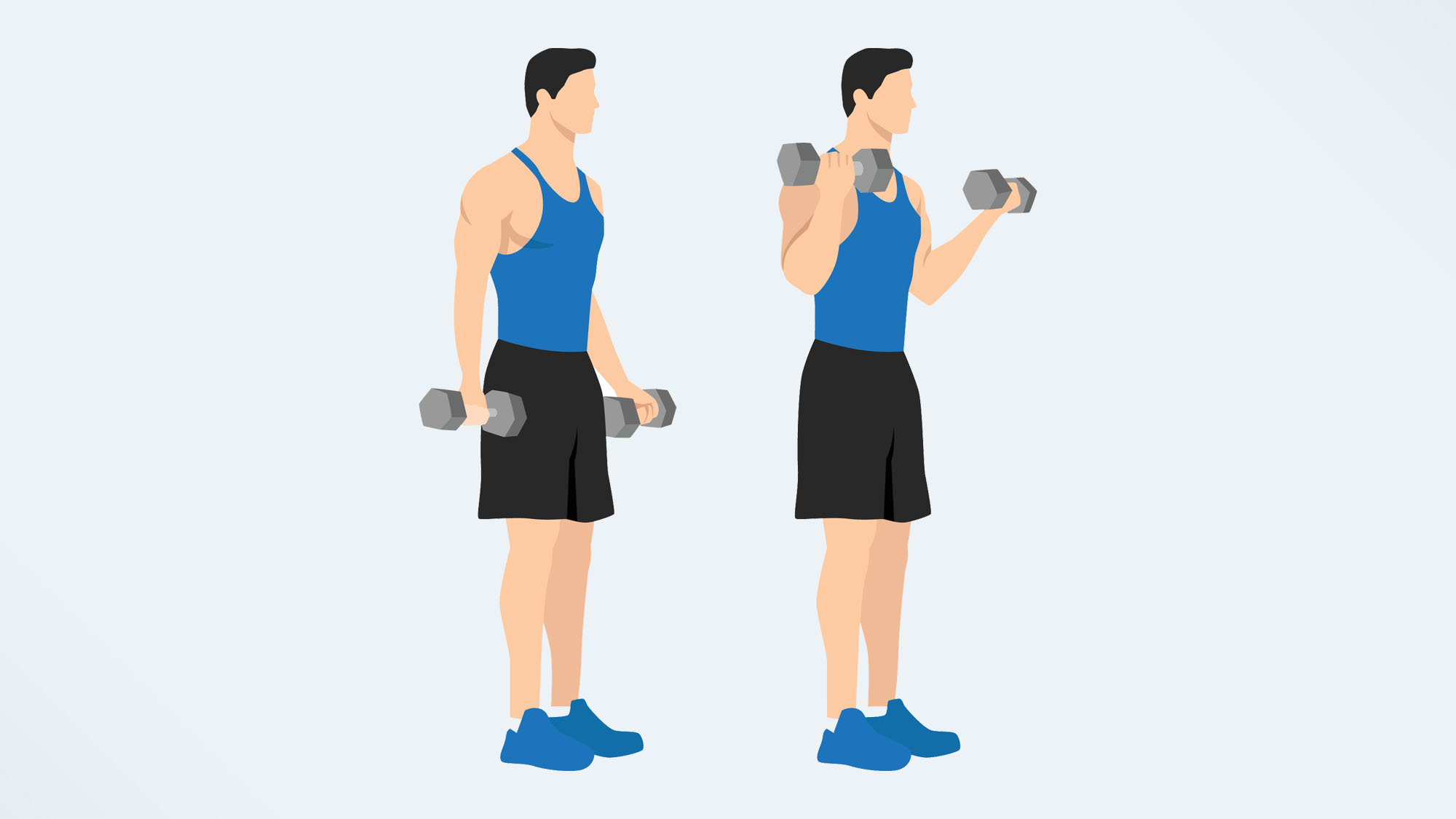I did biceps curls every day for a week — here’s what happened
This is one move that will never lose its flex appeal

Is there a muscle-building exercise that’s better known than the biceps curl? The push-up, maybe, but almost anyone can perform a biceps curl, with the right weight, while I know plenty of people who can’t manage even a single push-up. (One blasé friend of mine, who refuses to do any weight training, dropped to the floor on a summer’s afternoon to show the world they’re easier than they look. I think she’s still there.)
The biceps curl — "biceps" is the same word for singular and plural — is the move most people start off with when they want to build muscle in their upper arms. The main functions of the biceps are flexion of the elbow, outward rotation of the forearm, and making you look good when you wear a snug T-shirt. In basic terms, the curl involves engaging the biceps to lift a weight to the shoulder. Couldn’t be easier, right? Wrong.
Looking for more workout inspiration? Read what happened when I did 30 supermans a day for a week here, and when I did 50 sumo squats a day for a week here.
How to do a bicep curl
Begin by standing tall, feet about hip-width apart, with a dumbbell in each hand, palms facing forward. Your arms should be hanging by your sides, close to your torso. Choosing the right weight is crucial. You want to be lifting something that allows you to complete three sets of 10 curls without losing form. The last few reps should feel hard but not so much that you’re rocking back and forth like that guest at the wedding who thinks dancing has nothing to do with foot movement.
With your upper arms stationary and your shoulders relaxed and back, exhale and bend your elbows to raise the dumbbells to your shoulders. Hold for a moment at the top of the move, then inhale as you lower the weight back to the start position. That’s one rep. Keep your elbows close to your torso throughout; if they tend to flare out, lighten the load for now.
You may be tempted to only lower the weight about three-quarters of the way back down, leaving a slight bend in the elbow. To get the full benefit from the move, lower completely, maintaining tension in the biceps, before raising again.

It is a fairly straightforward move, but it’s equally easy to do it incorrectly. The most common error in form is the aforementioned rocking, which means you are using other parts of your body (primarily your hips) and your momentum to swing the weight upwards. The biceps curl is an isolation exercise, so the rest of your body should remain still as you raise and lower the weight. Engage your core to help you remain standing tall, and look forward. If you find you are swinging or rocking to lift the weight, choose lighter dumbbells. The heavier ones will still be there when you have built strength.
Get instant access to breaking news, the hottest reviews, great deals and helpful tips.
Control is paramount. Lift smoothly and take the same time to lower the weight. The benefit comes from the whole movement, not just the lifting.
I did 30 biceps curls every day for a week — here’s what happened
I started off with two 17.5lb dumbbells and was surprised at how difficult it was to maintain form. I was hinging at the hips to raise the weights for the final few reps and breathing hard by the end of each set. I was a little disappointed in myself, but far more so when I worked out the problem. My adjustable dumbbells are the kind that allows you to slide plates on and off, and I had not considered the weight of the bars and the metal collars (spinlocks) that keep those plates in place: 4.5lb each. So I was lifting two 22lb weights, which was more than I’d planned. So I took the weight down to 17.5lb on each side and felt like a dope for a while. (If you’re in the market for new dumbbells, check out the best adjustable dumbbells for weightlifting at home here.)
On day two, I finished the sets with no problems, though I noticed again a tendency to arch my back on the final reps. Watch out for this, as it’s an easy error to make and can quickly become ingrained. Just go to a gym and watch some of the guys – and it is almost always guys — arching themselves almost double as they try to lift their own body weight with each arm.
On day three, I alternated arms to reach the same number of reps and sets. It took a little longer, but lifting one weight at a time was, of course, easier. But it also may encourage a slight swing in the shoulders as you develop a rhythm, so keep an eye on that if you choose this method.
Day four: I maintained the alternating method and added five reps to every set; giving each arm that half-second break before a rep made quite a difference.
For day five, I decided to try hammer curls: the movement is the same, but you begin with your palms facing in (neutral position). You may find you can lift a slightly heavier weight with this variation, which also targets the brachioradialis, a forearm muscle used in flexion, as well as pronation (palms facing down) and supination (palms facing up, as in the standard biceps curl).
On days six and seven I mixed things up for the sets: standard curls, hammer curls, both arms at once, and alternating. Form kinks had been ironed out and I was enjoying the feeling of completing the three sets with greater ease as the week progressed.
I wasn’t expecting any noticeable muscle gains after a week of biceps curls, but if bigger arms were a goal, I would certainly incorporate them into my weight training: My arms at least feel bigger. That said, if a gun show is really what you’re after, you’ll need to also work on your triceps muscles, which are bigger than the biceps. Now, if you’ll excuse me, I have to go pull on a T-shirt that is ever-so-slightly too small for me.
Next: I just did Raven from Love is Blind’s 5-minute Pilates ab workout — and it’s a good one.
John is a writer and editor based in London. He was worked for magazines such as Runner’s World, Men’s Health, Women’s Health and Cosmopolitan. A keen runner, what he lacks in ability he makes up for with enthusiasm and excuses.

